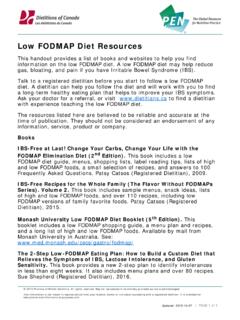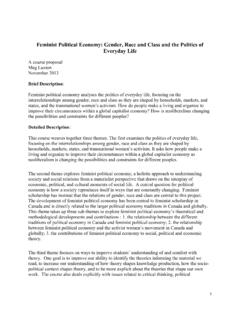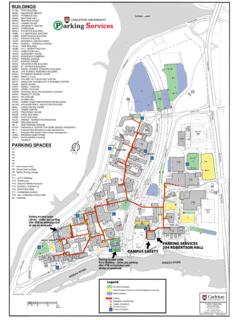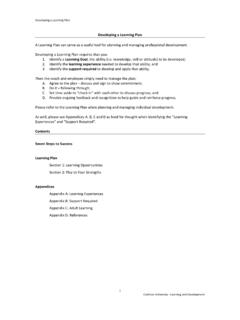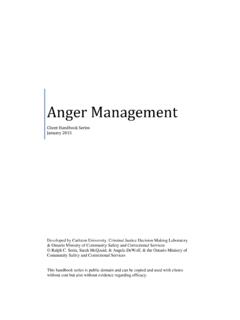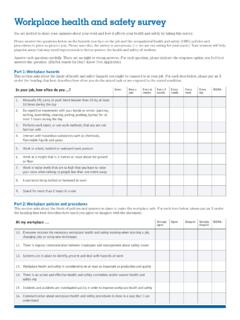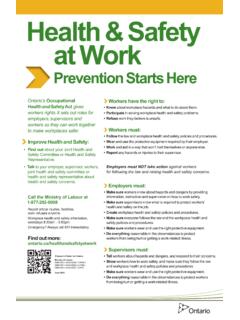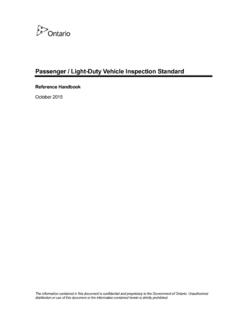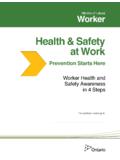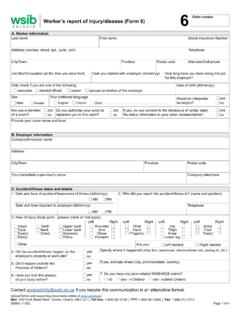Transcription of Appendix A - Workplace Violence Risk Assessment
1 Appendix A - Workplace Violence Risk Assessment PURPOSE: This Workplace Violence Risk Assessment is designed to assist the University in assessing the hazard of Workplace Violence and identifying possible measures, procedures and controls that can be implemented to control the risk of Violence in the Workplace . Workplace Violence is defined as (Occupational Health and safety Act, (1)): the exercise of physical force by a person against a Worker, in a Workplace , that causes or could cause physical injury to the Worker, an attempt to exercise physical force against a Worker, in a Workplace , that could cause physical injury to the Worker, a statement or behavior that it is reasonable for a Worker to interpret as a threat to exercise physical force against the Worker, in a Workplace , that could cause physical injury to the Worker.
2 INSTRUCTION: The Manager shall: Hold meetings with Workers to seek their input. This will assist to: identify risks that Workers perceive and their sense of personal safety in Workplace consider Workers' experience of Violence and whether the situation involved strangers, clients, co-Workers, students, estranged partners or family members identify jobs or locations in which Workplace Violence is a concern; and gather opinions about the effectiveness of the controls currently in place. The Department Head shall: Determine if there will be one set of assessments filled out for the entire department/faculty, or whether there will be separate assessments for different jobs, tasks, or locations with similar risks of Violence . For a large Workplace , the department head may wish to divide the department/faculty into Workplaces or tasks that have similar risks of Violence .
3 For example, a fee collection office may divide its staff into those that deal with customers personally and those who work in the office with no customer contact. Complete or arrange to have Managers complete the Risk Assessment (attached to this document). Send the original Risk Assessment to the Manager Risk and Insurance, Room 603. Robertson Hall by the specified date. Keep a copy of the Risk Assessment in the department/faculty for future reference. The Manager Risk and Insurance shall: Prepare an Assessment report that identifies areas of risk of Workplace Violence with recommendations for necessary risk control measures. Send the Assessment report to the Working Group on Workplace Harassment and Violence , as well as the Joint Occupation Health and safety Committee.
4 Send the necessary risk control measures to the Department Head for implementation. _____. Reference: 1. Occupational Health and safety Council of ontario - Workplace Violence Assessments January 2010. 2. Canadian Centre for Occupational Health and safety . Violence in the Workplace Prevention Guide. 3rd Edition. 3. Occupational Health and safety Act (as amended under Bill 168). 1. Risk Assessment Worksheet Faculty/Department Completed By: Name/Title Date Phone Part I - General Assessment 1. Physical Environment Do you or your workers have any concerns about risk of Workplace Violence pertaining to the physical environment? ( lighting, entry control and security system, public counters, interior design and hidden areas, Workplace location (neighbourhood).)
5 Yes No If yes, please indicate areas of concern: _____. _____. _____. _____. _____. _____. _____. _____. Examples of Controls ( , installed access card entry, increased lighting, rearranged work station, placed service request to install locks on doors etc.) taken: _____. _____. _____. _____. _____. _____. _____. _____. 2. Part II - Assessment of Current safety Programs After consulting with workers in the area, complete the following questionnaire on safety programs now in place on campus. Are Have workers If employees have used the workers in your program how often have in your Program area they use it? Other Comments area used aware of this this program? program? Frequently (once a week). Yes No Yes No Safewalk - provides a safewalk escort Often (once a month).
6 To your vehicle, bus stop or residence on request Seldom (once every 3 months). Working After Hours Frequently (once a week). Program Yes No Yes No University safety will Often (once a month). check in on you by phone or in person at pre-arranged intervals Seldom (once every 3 months). RAD Frequently (once a week). free self defense program for women teaches risk Yes No Yes No Often (once a month). awareness, hand-on instruction of physical defense training Seldom (once every 3 months). Panic Pendant Frequently (once a week). Personal Alarm Yes No Yes No -pendant worn around the Often (once a month). neck and works with intrusion alarm system. Activation of alarm sends signal to University safety Seldom (once every 3 months). Personal safety and Crime Prevention Yes No Yes No Brochures topics include harassment, personal safety , theft reduction safety Audit University safety personnel can conduct a Yes No Yes No safety audit of your work area on request safety Presentations Yes No Yes No University safety will attend your staff meeting on request and provide presentations on a variety of personal safety topics 3.
7 Part III - Identification and Assessment of Specific risks Factors Certain types of work or conditions can put workers at higher risk from Workplace Violence . Review the list of specific risks associated with the type of work or conditions of work included in the table below. If the risk exists, rate the risk using the guideline on the next page. Ranking or prioritizing the risk factors is one way to help determine which are the most serious safety hazards and therefore need to be addressed first ( by implementing controls) and the level of training required. Managers may complete a separate sheet for each group of workers with similar tasks. ( Administrative Assistants, Advisors, etc.). Faculty/Department: Job/position ( , office administrative staff, advisors etc.)
8 : Level of Risk Risk H = High M = Moderate Does Work Include: Examples of Activities or Situations Exists? L = Low (see Risk Method on Yes No next page). Direct contact with Working at complaint centre, appeals office the public including Involved in mediation students, workers or Carrying out legislative or policy enforcement customers with duties likelihood of dealing Service counter staff with irate persons Working at cashier station in a fixed location Handling money or Transporting cash to remote or isolated valuables locations or at night Providing a service to persons with Working with physiological, psychological, or psychiatric unstable or volatile conditions and substance abuse issues persons Working in premises where alcohol is served Working in a fixed location where there is limited or no access to communication tools (Research Lab).
9 Working in a fixed location where there is a high potential of assault or robbery ( safety officer). Working in isolated areas within a worksite, Working alone away from other workers ( CCS or Maintenance). Working in a remote worksite where public may have access Working during late evening hours or early morning hours ( Maintenance, CCS or Research Lab). Transporting student/staff to locations on or off campus (public has physical access to driver/staff). Mobile Workplace or Working in remote unknown areas transporting Working in areas where there is limited or no passengers as part of access to communication tools your job Working in situations where fare collection and enforcement of fares is required 4. Risk Assessment Method Category of Risk* = Severity + Frequency**.
10 Notes: * Risk inherent in the job assuming no controls in place. ** In this exercise, it is assumed that high frequency also leads to high probability of occurrence. Frequency Severity Category of Risk Regularly High High . Score = 3 Score = 3 Total score = 6. Exposure may be part of the normal work - potential for fatal or critical injury routine or assignment - may be exposed to physical injury from physical assault, punching, kicking, hitting, weapons Occasionally Moderate Moderate . Score = 2 Score = 2 Total score = 4 - 5. Exposure is infrequent - potential for lost time or health care - may be exposed to threatening behaviour such as hostile, intimidating, frightening etc. ( , shouting, pushing a table etc.). Rarely Low Low . Score = 1 Score = 1 Total score= 1 - 3.
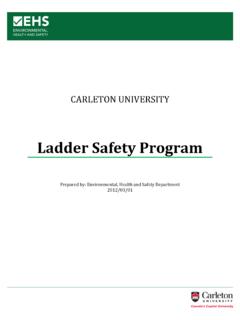
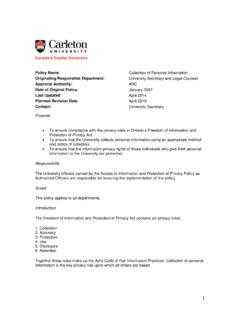
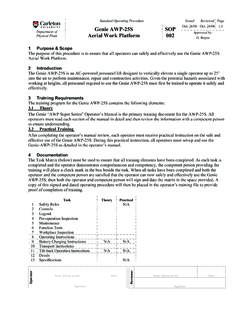
![MATH 1107E [0.5 Credit] Linear Algebra I - Carleton …](/cache/preview/8/c/7/6/6/6/2/e/thumb-8c76662e741e6e47ff8d6ae4a7a3fe3d.jpg)
